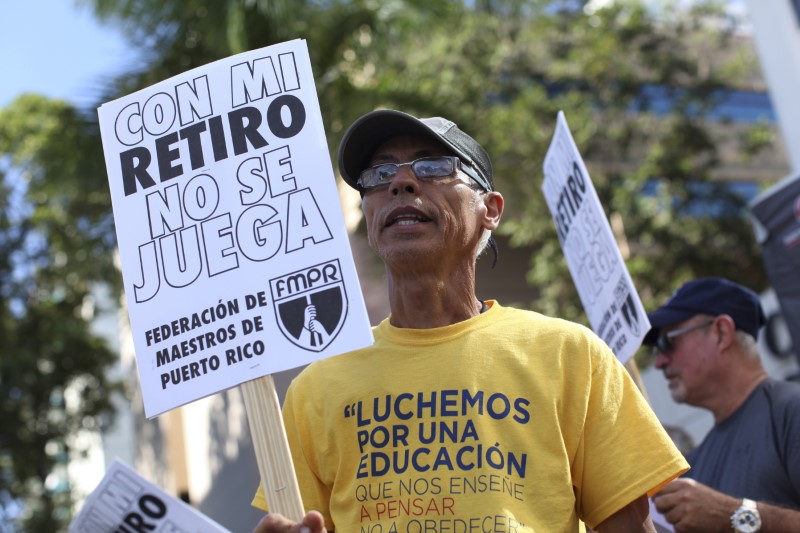By Nick Brown
(Reuters) - As Puerto Rico attempts to sort out its tangled financial web, retirees may face bigger cuts than those in past U.S. municipal insolvencies, due in part to an unconventional debt structure that pits pensioners against the very lenders whose money was supposed to sustain them.
The U.S. territory is doing all it can to present itself as a reliable place to invest, but resolving the pensions issue will require a careful balance.
Benefit structures are widely seen as unsustainable, but draconian cuts to pensioners could deepen the population's reliance on government subsidies and compound rampant emigration.
"Many of our retirees are already under the poverty line," Puerto Rico Governor Ricardo Rossello told Reuters in an interview this past week, saying any pension cuts would attempt to protect the poorest beneficiaries. "Impacting them would be to cast them out and challenge their livelihood."
The tropical island, struggling with a 45 percent poverty rate and unemployment more than twice the U.S. national average, is working to restructure nearly $70 billion in debt. Public pensions, which owe $45 billion in benefits, are also virtually insolvent after generations of lawmakers ignored growing funding gaps or botched attempts to close them.
Now the pensions have almost no cash and a nearly 100 percent funding shortfall that is thought to be the largest ever for comparably-sized U.S. public pensions. Paying pension benefits out of the island's general fund, on a pay-as-you-go basis, could cost Puerto Rico $1.5 billion a year.
A federally-appointed board tasked with managing the territory's finances has recommended the governor cut 10 percent in annual pension costs, or about $200 million. Rossello is scheduled on Tuesday to present the board with a ten-year blueprint for the island's fiscal turnaround, which is expected to include the proposed pension cuts.
PENSIONERS, LENDERS CLASH
But Puerto Rico's pensioners will not take deep cuts to benefits lying down. They have formed a negotiating committee, advised by Robert Gordon, an attorney who advised retirees in Detroit's landmark 2013 bankruptcy, and Hector Mayol, the former administrator of Puerto Rico's pensions and also a lawyer.
But their prospects are dimmer than retirees in Detroit, whose benefit cuts were generally limited to a few percentage points, or the elimination of cost of living adjustments.
Puerto Rico's "unusual circumstances mean that it will not conform exactly" to recent public bankruptcies, in which "judges reduced creditor claims far more than amounts owed to pensioners," Moody's Investors Service wrote earlier this month.
The sheer size of Puerto Rico's pension gap is one such unusual circumstance, while the peculiar debt structure that pits some retirees against the pension's own lenders is another.
Puerto Rico's largest public pension, known as the Employee Retirement System (ERS), covers nearly 100,000 retirees and is slated to run out of cash this year. In addition to paying retiree benefits, ERS is on the hook for $3.1 billion to repay bonds it issued in 2008 - specifically to keep the pension afloat.
Pension obligation bonds are traditionally issued by a government with the proceeds going to pensions. But Puerto Rico's were sold by the ERS itself, and secured by contributions from public employers - a maneuver designed to skirt the need for legislative approval.
The pension's debt service reserves will run out by May, according to Moody's.
With additional employer contributions frozen, default seems likely, setting the stage for an unusual conflict in which retirees and pension bondholders compete over claims to some of the same assets.
"This is a significant flashpoint of conflict," Ted Hampton, an analyst with Moody's, said in an interview last week. "Retirees were promised certain benefits, and may have no other source of income. But ERS bondholders may be people who bought the bonds to create their own retirement nest egg.”
TARGETED CUTS
Like retirees, ERS bondholders have also hired lawyers. A group led by hedge funds Claren Road and Altair tapped attorney and bankruptcy guru Bruce Bennett.
The group sued the Puerto Rico government last fall over its stoppage of pension contributions, eventually settling on a stipulation to freeze contributions in a trust while debt restructuring talks play out.
Both groups are expected to absorb cuts, and the competing claims likely mean smaller recoveries for both sides. The dispute highlights Puerto Rico's extraordinarily dire financial straits, and is indicative of the island’s penchant for testing borrowing limits in ways that ultimately deepened its hole. The unconventional bonds not only failed to stave off ERS' insolvency, they added to its liabilities and muddied the path to resolution for retirees.
Rossello has said cuts to pensioners outlined in Tuesday's plan will be targeted, with the biggest cuts hitting those with the cushiest benefits. "The most vulnerable retirees are not going to take a hit," he said.
But such targeted cuts could run into legal challenges from pensioners upset at the prospect of unequal treatment for members of the same pension plan.
"There's no basis by which you could justify that, if a person worked a set number of years and is getting the pension the formula dictated," said Mayol, one of the lawyers representing the retiree committee.
